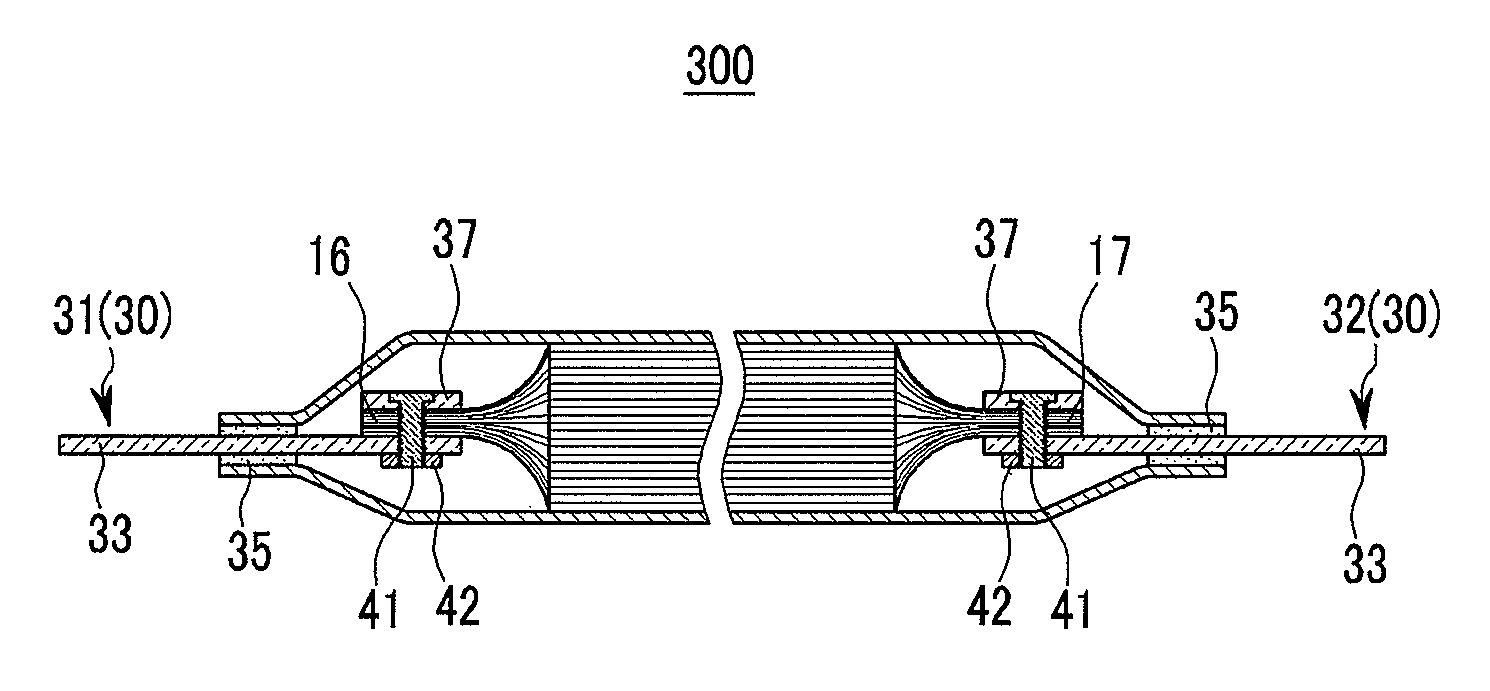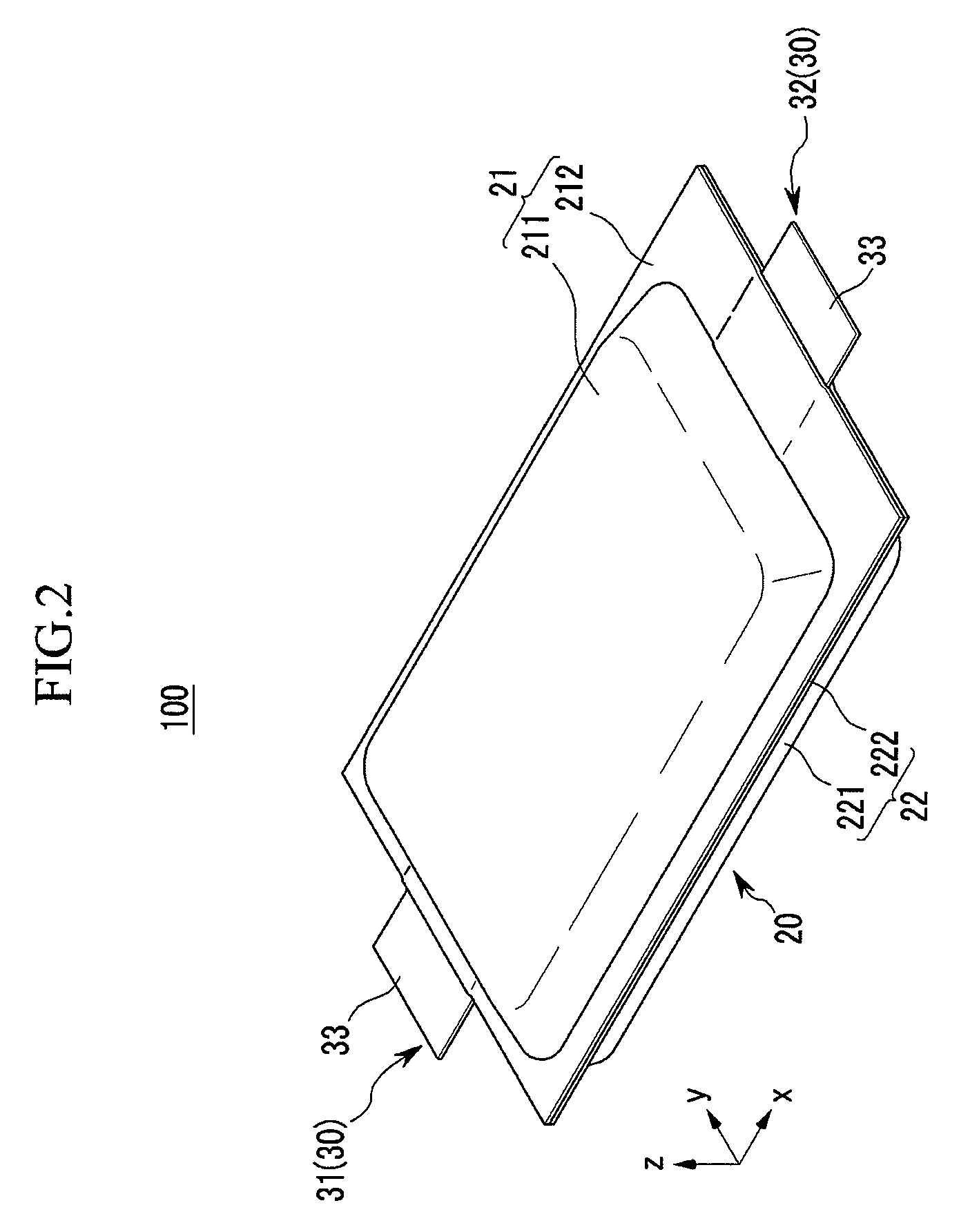Rechargeable battery
a rechargeable battery technology, applied in the field of rechargeable batteries, can solve the problems of reducing output performance, deteriorating durability, and degrading rigidity, and achieve the effects of increasing rigidity and durability, improving the bonding structure of the electrode terminal, and increasing output performan
- Summary
- Abstract
- Description
- Claims
- Application Information
AI Technical Summary
Benefits of technology
Problems solved by technology
Method used
Image
Examples
first embodiment
[0039]FIG. 1 shows an exploded perspective view of a rechargeable battery 100 according to the present invention, and FIG. 2 shows a combined state perspective view of a rechargeable battery shown in FIG. 1.
[0040]Referring to FIG. 1 and FIG. 2, the rechargeable battery 100 can include an electrode assembly 10, a case 20 for receiving the electrode assembly 10, and an electrode terminal 30 connected to the electrode assembly 10 and drawn outside the case 20. In this instance, the electrode terminal 30 may be formed to surround the top, bottom, and sides of an anode current collector 16 and a cathode current collector 17.
[0041]The electrode assembly 10 may have a stacked structure of a plurality sheets of anodes, separators, and cathodes, or it may have a structure in which a piece of an anode, a separator, and a cathode are stored and then rolled in a jelly roll form.
[0042]FIG. 3 shows a front view of an electrode assembly in a rechargeable battery shown in FIG. 1, exemplifying a lay...
second embodiment
[0064]FIG. 6 shows a partially magnified cross-sectional view of a rechargeable battery 200 according to the present invention.
[0065]Referring to FIG. 6, the rechargeable battery 200 according to the exemplary embodiment has the same configuration as the rechargeable battery according to the first embodiment, except for the use of a rivet 40 in combining the electrode terminal 30 and the current collectors 16 and 17, rather than a weld. The same members as those of the rechargeable battery according to first embodiment use the same reference numerals.
third embodiment
[0066]FIG. 7 shows a partially magnified cross-sectional view of a rechargeable battery 300 according to the present invention.
[0067]Referring to FIG. 7, the rechargeable battery 300 according to the third embodiment has the same configuration as that of the rechargeable battery according to the first exemplary embodiment, except for the use of a bolt 41 and nut 42 assembly in combining the electrode terminal 30 and the current collectors 16 and 17, rather than a weld. The same members as those of the rechargeable battery according to the first embodiment use the same reference numerals.
[0068]In the second embodiment and the third embodiment, conductive fastening members such as the rivet 40 or the bolt 41 may be used to fasten the electrode terminal 30 and the current collectors 16 and 17. In this case, an opening may be formed to be passed through the cover 37, the current collectors 16 and 17, and the terminal plate 33, and the conductive fastening member may be provided to be se...
PUM
| Property | Measurement | Unit |
|---|---|---|
| inner volume | aaaaa | aaaaa |
| conductive | aaaaa | aaaaa |
| height | aaaaa | aaaaa |
Abstract
Description
Claims
Application Information
 Login to View More
Login to View More - R&D
- Intellectual Property
- Life Sciences
- Materials
- Tech Scout
- Unparalleled Data Quality
- Higher Quality Content
- 60% Fewer Hallucinations
Browse by: Latest US Patents, China's latest patents, Technical Efficacy Thesaurus, Application Domain, Technology Topic, Popular Technical Reports.
© 2025 PatSnap. All rights reserved.Legal|Privacy policy|Modern Slavery Act Transparency Statement|Sitemap|About US| Contact US: help@patsnap.com



